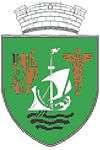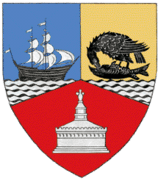Mangalia
| Mangalia | ||
|---|---|---|
| Municipality | ||
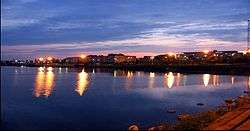 | ||
| ||
 Mangalia Location of Mangalia | ||
| Coordinates: 43°49′02″N 28°34′58″E / 43.81722°N 28.58278°ECoordinates: 43°49′02″N 28°34′58″E / 43.81722°N 28.58278°E | ||
| Country |
| |
| County | Constanța County | |
| Status | Municipality | |
| Government | ||
| • Mayor | Cristian Radu[1] (National Liberal Party) | |
| Area | ||
| • Total | 62.26 km2 (24.04 sq mi) | |
| Elevation | 20 m (70 ft) | |
| Population (2011[2]) | ||
| • Total |
| |
| Time zone | EET (UTC+2) | |
| • Summer (DST) | EEST (UTC+3) | |
| Climate | Cfa | |
| Website | http://www.mangalia.ro/ | |
Mangalia (Romanian pronunciation: [maŋˈɡalia], Turkish: Mankalya, ancient Callatis (Greek: Κάλλατις/Καλλατίς), other historical names: Pangalia, Panglicara, Tomisovara), is a city and a port on the coast of the Black Sea in the south-east of Constanța County, Romania.
The municipality of Mangalia also administers several summer time seaside resorts: Cap Aurora, Jupiter, Neptun, Olimp, Saturn, Venus.
History
The Greek town Callatis existed until mid 7th century under this name. Life in the town resumed from 10th century. In the 13th century Callatis came to be known as Pangalia [3] The Vlachs called it Tomisovara[4] and the Greeks - Panglicara.[4] From 16th c. the town had acquired its present name Mangalia. A Greek colony named Callatis was founded in the 6th century BC by the city of Heraclea Pontica.[5] Its first silver coinage was minted approximately 350 BC. In 72 BC, Callatis was conquered by the Roman general Lucullus and was assigned to the Roman province of Moesia Inferior. Throughout the 2nd century AD, the city built defensive fortifications and the minting of coinage under the Roman emperors Septimius Severus and Caracalla continued. Callatis suffered multiple invasions in the 3rd century AD but recovered in the 4th century AD to regain its status as an important trade hub and port city.[6] From 7th to 11th century the city was under the rule of the First Bulgarian Empire.
Geography and climate
Mangalia is positioned at 43°49’ latitude and 28°35’ longitude, with an approximate elevation of 10 meters, 44 kilometres (27 miles) south of the municipality of Constanţa, on the same latitude as the French resort of Nice. Mangalia is one of the southernmost resorts on the Romanian coast of the Black Sea.
Mangalia is characterized by a moderate maritime climate (annual average temperature 11 °C (52 °F) - one of the highest in Romania) with hot summers (July average over 21 °C (70 °F)) and mild winters (January average 1 °C (34 °F)), Mangalia being the country's second place, after Băile Herculane, with positive average temperatures in wintertime. Spring comes early but is cool and autumn is long and warm. In summer, cloudiness is reduced (about 25 sunny days in a month) and the duration of sunshine is of 10–12 hours a day. Annual precipitation is low (about 400 mm (16 in)).
The sea breeze is stronger in summer. The natural cure factors are the water of the Black Sea, which is chlorided, sulphated, sodic, magnesian, hypotonic (mineralization 15.5g), the sulphurous, chlorided, bicarbonated, sodic, calcic, mesothermal (21-28 °C) mineral waters of the springs in the northern part of the city, in the area of the beach between Saturn and Venus, the sulphurous peat mud, rich in minerals, which is extracted from the peat bog north of the city (expected to last another 250 years) and the marine climate, rich in saline aerosols and solar radiation that have a bracing effect on the organism.
The resort has a large, fine-sand beach developed for purposes of aeroheliotherapy and wave therapy, as well as high seawalls with a specific microclimate where one may benefit from inhalations of saline aerosols having therapeutic effects.
| Climate data for Mangalia | |||||||||||||
|---|---|---|---|---|---|---|---|---|---|---|---|---|---|
| Month | Jan | Feb | Mar | Apr | May | Jun | Jul | Aug | Sep | Oct | Nov | Dec | Year |
| Average high °C (°F) | 5 (41) |
6 (43) |
9 (48) |
13 (55) |
19 (66) |
23 (73) |
26 (79) |
26 (79) |
22 (72) |
17 (63) |
11 (52) |
7 (45) |
15 (59) |
| Average low °C (°F) | −2 (28) |
−1 (30) |
2 (36) |
7 (45) |
12 (54) |
16 (61) |
18 (64) |
18 (64) |
14 (57) |
10 (50) |
4 (39) |
1 (34) |
8 (46) |
| Source: Weatherbase [7] | |||||||||||||
Demographics
| Historical population | ||
|---|---|---|
| Year | Pop. | ±% |
| 1912 | 1,929 | — |
| 1930 | 2,764 | +43.3% |
| 1948 | 4,547 | +64.5% |
| 1956 | 4,792 | +5.4% |
| 1966 | 12,674 | +164.5% |
| 1977 | 26,821 | +111.6% |
| 1992 | 43,960 | +63.9% |
| 2002 | 40,037 | −8.9% |
| 2011 | 36,364 | −9.2% |
| Source: Census data | ||
At the 2011 census, 90.6% of the city's residents were ethnic Romanians, 4.4% Turks, 3.6% Tatars, 0.5% Roma, 0.3% Lipovans, and 0.6% belonged to other ethnic groups. According to religion, for respondents for whom data is available, 89.5% were Romanian Orthodox, 8.3% Muslim, 0.9% Roman Catholic, 0.3% Pentecostal, and 1% other or none.
Tourist attractions
- The city has been well known in recent years as the place where one of the largest summer festivals in Romania takes place: Callatis Festival;
- The Scythian tomb discovered in 1959 where archaeologists unearthed fragments of a papyrus in Greek, the first document of this kind in Romania;
- The incineration tombs (the necropolis of the Callatis citadel, dating back to the 4th-2nd centuries BC);
- The ruins of the Callatis citadel (6th century BC);
- The Turkish Mangalia Mosque(Esmehan Sultan Mosque) (16th century);
- The Archaeology Museum which shelters a rich collection of amphorae and sculptures from the Hellenistic epoch, fragments of stone sarcophagi;
- Mangalia Marina
Gallery
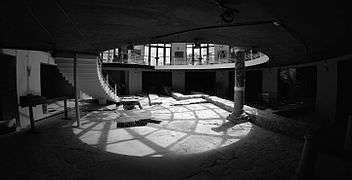 4th–7th century Roman-Byzantine archaeological display from the ancient city of Callatis, housed in the basement of Hotel President
4th–7th century Roman-Byzantine archaeological display from the ancient city of Callatis, housed in the basement of Hotel President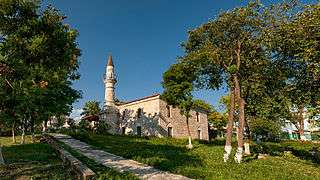
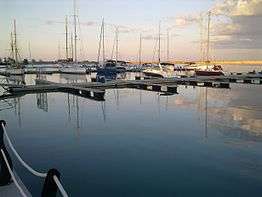 Marina
Marina
Natives
- Satyrus the Peripatetic (c. 3rd century BC), Greek peripatetic philosopher and historian
- Inna, singer
Politics
The current mayor of Mangalia is Cristian Radu (Independent).
The Mangalia Municipal Council, elected in the 2012 local government elections, is made up of 19 councilors, with the following party composition:
| Party | Seats | Current Council | |||||
|---|---|---|---|---|---|---|---|
| Social Democratic Party | 6 | ||||||
| Democratic Liberal Party | 6 | ||||||
| National Liberal Party | 4 | ||||||
| Conservative Party | 2 | ||||||
| Greater Romania Party | 1 | ||||||
International relations
Twin towns – sister cities
|
References
| Wikimedia Commons has media related to Mangalia. |
- ↑ "Luptă strânsă pentru Consiliul Judeţean Constanţa între PSD şi PNL. Noua garnitură de primari" (in Romanian). Ziua de Constanța. 7 June 2016. Retrieved 7 June 2016.
- ↑ "Constanta County at the 2011 census" (PDF) (in Romanian). INSSE. February 2, 2012. Retrieved March 8, 2012.
- ↑ Preda, C. 1968: Callatis. Bucharest.
- 1 2 Innocenzi, Alfredo (2016-03-01). Dobrogea:o frontiera uitata (in Romanian). Youcanprint. ISBN 9788893328678.
- ↑ Amphoras from Callatis (Romania), International Journal of Nautical Archaeology,
- ↑ Michael Grant, "A Guide to the Ancient World", New York: Barnes and Noble Books 1997, p. 140.
- ↑ "Weatherbase data Mangalia".
- ↑ Archived April 21, 2012, at the Wayback Machine.
- Alexandru Avram. Kallatis. - In: Ancient Greek Colonies in the Black Sea. Vol. 1. Eds. Dimitrios V. Grammenos and Elias K. Petropoulos. Oxford, Archaeopress, 2001 (BAR International Series; 1675 (1-2)), 239-286.
